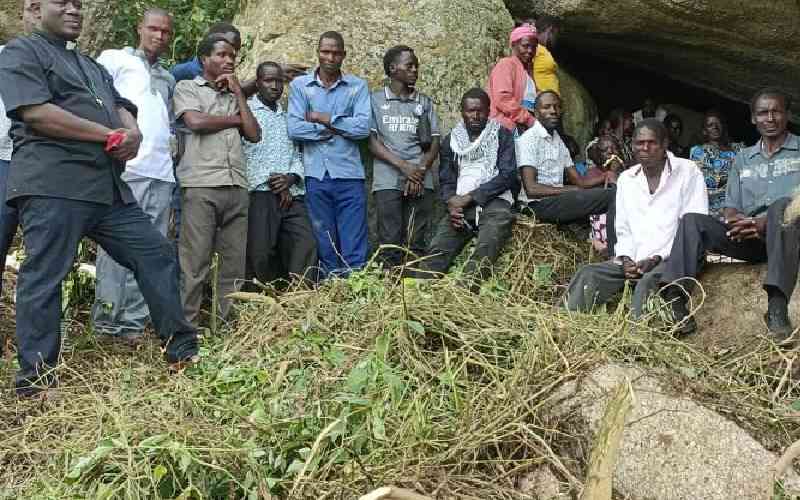Kenyans are increasingly embracing straw bale technology, which uses materials made entirely out of farm waste, to build cheaper and environmentally-friendly dream homes, writes KEVIN OGUOKO
Jackline Marambo works as a pharmacist at Gundua Health Centre in Timau on the Nanyuki-Meru highway. Lying northwest of Mount Kenya, Timau’s weather can go as low as seven degrees Celsius in January.
Instead of the conventional stone building, the health centre has used straw bale — materials made entirely out of farm waste, readily available from wheat farms throughout Kenya — to construct staff houses.
“It is very cold in this place. But once I enter my house, the atmosphere is completely different. The inside is warm and comfortable, especially at night,” says Jackline, who resides in one of the health centre’s staff houses.
Gundua Health Centre is one the institutions and individuals who have embraced the straw bale technology to build houses in the area. They say the technology is not only cheap, but also ensures maximum protection from the cold weather. This affordable green building technology has got residents in Nanyuki and its environs excited as more and more people turn to it to build their homes.
Constant temperature
“One of the key advantages of straw bale structures is their thermal insulation attribute. Straw bale housing is one of the most efficient means of keeping a constant temperature where heating or cooling of the home is essential for comfort,” says Peter Kamau, a Masters student at University of Nairobi who recently completed doing his thesis on straw bale technology titled, Straw Bale as a Sustainable Building Material: A Thermal Comfort Comparison with Brick and Stone Buildings.
The insulation reduces unwanted heat loss or heat gain by keeping room temperature constant. A well-built straw bale home can save up to 75 per cent on heating and cooling costs. The natural cooling cycles of the planet are enough to keep the house cool all summer long, say experts.
The backers of the building technology, Kuza Nyumba Construction, are targeting the lower middle class for a house with entry level similar to the popular Suraya Starter Homes. Using the technology, one can spend about Sh1 million to put up a one-bedroom house.
This method involves the use of materials made entirely out of farm waste, which are readily available from wheat farms throughout Kenya. Once the edible part of a grain such as wheat or rice has been harvested, the stalks often become a disposal problem for farmers. By bailing the straw, a new life is given to the material.
Rural economies
“As straw is often discarded on rural farms due to its poor nutritional value for animals, we purchase it from farmers and use it for construction. This creates a new income stream for farmers, thus improving rural economies where wheat and barley and rice are grown,” says Michael Spencer, the designer and consultant from the United States responsible for overseeing the introduction of straw bale technology in Kenya.
He adds: “Straw bale technology can also be viewed as an investment. In their endeavour to make affordable houses, the farmers will also be making a little money on the side.”
According to Michael Kinyua, the director of Kuza Nyumba Construction who has partnered with Michael Spencer in the introduction of straw bale technology in Kenya, straw bale can reduce the building construction costs by 20 per cent to 30 per cent.
In Nanyuki where Kuza Nyumba has completed a number of projects, one straw bale block of 36 by 19 by 14 inches goes for about Sh100. One of the main reasons for the low-cost is its supply as most of the bales are sourced from the farms around Nanyuki where the straw is treated as waste.
Stay informed. Subscribe to our newsletter
Straw bale housing is advantageous when it comes to constructing the building foundation.
“Straw bale is not as heavy as stones. Because of this, one does not need a deep and overly strong foundation. This makes the construction of the house cheaper,” says Kinyua. Currently, the technology is being used to construct a restaurant in the prestigious Kongoni Camp Hotel located a short distance outside Nanyuki Town on the Nanyuki-Meru highway. Besides providing insulation, the straw bale blocks will sound-proof the restaurant, which will also be used for entertainment.
“Straw bale buildings also provide sound insulation; there is almost no sound transmission between two rooms in a straw bale home, making it a wonderful building solution for people living in close proximity to each other,” says Kinyua.
Once completed, the hotel management plans to build office blocks before moving on to construct more rooms for the lodge. “The technology is cost-effective and quite attractive to the eye. It also conserves the environment. We are excited to go for it in our new construction projects,” says Edwin Anderson, the general manager of Kongoni Lodge.
The erection of straw bale walls moves fast. A team of eight unskilled builders can stack the walls of a small house in a single day. Straw bale building typically involves stacking rows of bales often in a running-bond on a raised footing or foundation, with a moisture barrier or capillary break between the bales and their supporting platform.
In Kongoni Camp’s case, the straw bale blocks are placed above a wooden 4 by 2 deck covered with used motor oil in line with its green technology theme.
“Straw bale walls need to be kept dry as moisture is detrimental to not only straw, but also to many building materials. Moisture entering the bales from the roof above is to be avoided at all costs. If the walls of your straw bale home are kept dry, they will last for the life of the building,” says Michael Kinyua.
Owing to this, the use of straw bale houses in humid places like Mombasa and Kisumu is not viable, says Kinyua. Making this one of the shortcomings of straw bale building projects. Bale walls can be tied together with bamboo pins, rebar or with surface wire meshes as in Kongoni’s case, and then plastered, either with a cement-based mix, lime-based formulation or earth/clay render.
For aesthetic appeal, straw bale houses can be modified with wood finishes to give them that extra luxurious interior finishing. Because of its ‘block nature’, straw bale houses allow for carvings to be made inside the walls too.
“We are doing projects for all classes of people, ranging from small shamba houses to large luxurious homes. For these, we do extra finish works and interior finishes, which come at an extra cost, in the process diverging from the affordable housing concept that the buildings are solely based on,” says Kinyua.
Kuza Nyumba Construction is not only confined in the Central and Eastern regions as the construction firm has been contracted to put up various homes in Machakos and outside Nairobi over the coming months.
The technology has been used successfully in the US and Europe for over 100 years, with buildings from the 1890s still standing and in good condition.
“Straw bale technology is a housing technology that has been overlooked in Kenya. The problem is that many people have this perception that they cannot build houses with straw bale,” says Peter Kamau in his thesis. “They consider it a poor man’s house.”
Another problem with straw bale housing arises from its approval. Straw bale building codes are not part of Kenya’s building codes, so it may take a bit more work and time to get building plans of straw bale houses approved.
In his research, Kamau came across a straw bale building in Athi River, which was in a bad shape. He advises that straw bale is an organic material, which is fragile and so should be handled by construction experts lest the perception that straw bale is ‘not strong’ enough keeps going around.
“Care needs to be taken during its construction to ensure humidity, which is the greatest threat, does not penetrate through the straws,” says Kinyua.
 The Standard Group Plc is a
multi-media organization with investments in media platforms spanning newspaper
print operations, television, radio broadcasting, digital and online services. The
Standard Group is recognized as a leading multi-media house in Kenya with a key
influence in matters of national and international interest.
The Standard Group Plc is a
multi-media organization with investments in media platforms spanning newspaper
print operations, television, radio broadcasting, digital and online services. The
Standard Group is recognized as a leading multi-media house in Kenya with a key
influence in matters of national and international interest.
 The Standard Group Plc is a
multi-media organization with investments in media platforms spanning newspaper
print operations, television, radio broadcasting, digital and online services. The
Standard Group is recognized as a leading multi-media house in Kenya with a key
influence in matters of national and international interest.
The Standard Group Plc is a
multi-media organization with investments in media platforms spanning newspaper
print operations, television, radio broadcasting, digital and online services. The
Standard Group is recognized as a leading multi-media house in Kenya with a key
influence in matters of national and international interest.









